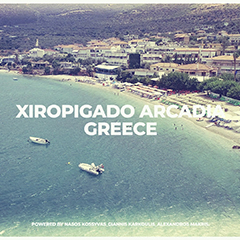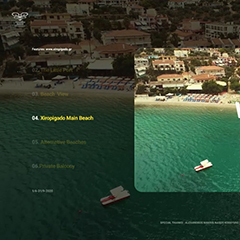Nafplio
One of the most beautiful towns in the area of Argolis (in eastern Peloponnese) as well as one of the most romantic cities all over Greece, Nafplio was the first capital of the newly born Greek state between 1823 and 1834.
According to mythology, the town was founded by Náfplios, the son of god Poseidon and the daughter of Danaus (Danaida) Anymone. The town’s history traces back to the prehistoric era when soldiers from here participated in the Argonautic expedition and the Trojan War alike. The town declined during the Roman times and flourished again during the Byzantine times. Frankish, Venetian and Turkish conquerors left their mark in the town and strongly influenced its culture, architecture and traditions during the centuries. Ancient walls, medieval castles, monuments and statues, Ottoman fountains and Venetian or neoclassical buildings mesmerize the visitor with their unique architecture and beauty..
Follow a dream trail to discover Náfplio’s precious gems starting from the medieval Old Town, the narrow cobblestone alleys, the neoclassical well preserved mansions with the Bougainvillea trees adorning their yards and balconies and the Turkish fountains.
Epidaurus Theater
The Epidaurus Ancient Theatre is a theatre in the Greek city of Epidaurus, located on the southeast end of the sanctuary dedicated to the ancient Greek God of medicine, Asclepius. It is built on the west side of Cynortion Mountain, near modern Lygourio, and belongs to the Epidaurus Municipality. It is considered to be the most perfect ancient Greek theatre with regard to acoustics and aesthetics.
According to Pausanias, the ancient theatre was constructed by the architect Polykleitos the Younger. Pausanias praises the theatre for its symmetry and beauty. At a maximum capacity of 13,000 to 14,000 spectators, the theatre hosted music, singing and dramatic games that were included in the worship of Asclepius. It was also used as a means to heal patients, since there was a belief that the observation of dramatic shows had positive effects on mental and physical health.
Today, the monument attracts a large number of Greek and foreign visitors and is used for the performance of ancient drama plays. The first modern performance conducted at the Epidaurus theatre was Sofocles's tragedy Electra. It was played in 1938, directed by Dimitris Rontiris, starring Katina Paxinou and Eleni Papadaki.
Mycenae
Mycenae is an archaeological site in Greece, located about 90 kilometres southwest of Athens, in the north-eastern Peloponnese. Argos is 11 kilometres to the south Corinth, 48 kilometres to the north. From the hill on which the palace was located, one can see across the Argolid to the Saronic Gulf.
In the second millennium BC, Mycenae was one of the major centres of Greek civilization, a military stronghold which dominated much of southern Greece. The period of Greek history from about 1600 BC to about 1100 BC is called Mycenaean in reference to Mycenae. At its peak in 1350 BC, the citadel and lower town had a population of 30,000 and an area of 32 hectares.The first correct identification of Mycenae in modern literature was during a survey conducted by Francesco Grimani, commissioned by the Provveditore Generale of the Kingdom of the Morea in 1700, who used Pausanias's description of the Lion Gate to identify the ruins of Mycenae.
Paralio Astros
One of the most famous summer resorts of Peloponnisos, with great development because of the short distance from big cities. 165km from Athens and 49 from Tripolis. It has developed touristic substructures for every taste, crystal clear beaches and water sports.
You can visit it all year round, ideal for weekends. There you can find a Sailing Centre, and you can visit the villages of Kynouria and the islands of Argosaronikos. The picturesque natural port is amazing, but the so called from the locals "Nisi" with an incredible view to the Argolic Bay. "Nisi" is called a part of the area that is built on the side of the hill.
The houses of that region have kept their traditional colour and on top there is the well-known kedieval castle. Every summer in the local theatre take place a lot of cultural festivals and sports events.
Saint Peter Village
Village in Parnonas full of green.It offers excellent accommodation with hotels, tavernas, shops with local products, it is a destination all year round, since it covers all the tastes. 192km from Athens, 36 from Tripolis, Agios Petros is a traditional area that satisfies every visitor.
Its most famous sights are The church of Apostles Peter and Paul in the square, the Tower of Trikalitis, the renovated stone school - an excellent sample of architecture of that period, the Tower of Agas of the 18th century, the old carpet factory and the stone made bridge.
The history of the village is special, since 1821 Captain Anagnostis Kontakis revolted and in 1826 set on fire against Imbraim. The visit to Agios Petros cannot be combined to the visit to the famous monastery of the area, the monastery of Malevis. Those who love climbing and nature will love it, since from the village start paths that end up in Mikri Tourla and Megali Tourla, the highest top of Parnonas, in 1936m far from the shelter, where you can stay for 6 hours. In the village the visitor can meet the tradition through the fete, that are organised because of religious celebrations, as in the rest area (between Agios Petros - Agios Ioannis) there is the Castle of Oria or Estella, where you can see ruins of a village and a fort.
Leonidio Village
Leonidio is a town and a former municipality in Arcadia, Peloponnese, Greece. Since the 2011 local government reform it is part of the municipality South Kynouria, of which it is a municipal unit. The municipal unit has an area of 418.652 km2, the community 102.667 km2. It is considered a traditional settlement.
The town of Leonidio, with a population of 3.826, emerges from a spectacular landscape, bound by two abrupt mountainsides enclosing the town from the north and south. The River Dafnon passes through the town, and its banks are linked with three bridges. The town is capital of the Tsakonia region, notable for its cultural and linguistic particularities, and the settlement itself offers striking and picturesque architecture; now a protected architectural site, there are very strict regulations for building within the town's limits.
Kastri Village
Great village that took its name from the complex of the seven villages of Kastri, as the biggest one of the region until 1960. The other villages are Messoraxi, Perdikobrisi, Nea Xora,Karatoulas, Oria and Elatos.
It is 25km from Tripolis and 950m from the sea level and consists a traditional mountainous village that combines both relaxation and recreation, such as trekking, the exploration of mountainous nature and the gorges of Parnonas but offers the possibility of religious uplift, as northeast of the village there is one of the most picturesque monasteries, that one of the Saint John the Baptist. It offers accommodation with rented rooms and lots of tavernas for food.
The visitors can meet the culture through icon-stands, watermills, yards and traditional fountains that exist until nowadays and explore the environment and nature of Parnonas through the Environmental Educational Centre that runs in the square.
For those who worship driving through nature, there is a road from the village via Vourvoura and Karya to the national road Tripolis-Sparti. In Kastri acted Zacharias Varvitsiotis with a great participation in the Struggle of 1821.









